Aquatic Invertebrates
Media
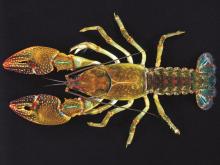
Species Types
Scientific Name
Lacunicambarus polychromatus (syn. Cambarus polychromatus)
Description
The paintedhand mudbug is a burrowing crayfish known in Missouri from only a few locations along the eastern border of the Bootheel. It is tan to olive green, and the abdominal segments and tail fan are trimmed with red. The pincers have red spots and red tips.
Media
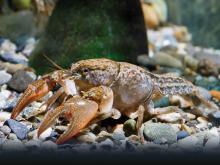
Species Types
Scientific Name
Creaserinus fodiens (formerly Fallicambarus fodiens)
Description
The digger crayfish is heavy-bodied, reddish tan, with a pale, iridescent stripe along the midline of the abdomen and short, broad pincers. In Missouri, it is known from only a few locations, mostly in southeastern counties.
Media

Species Types
Scientific Name
Lacunicambarus aff. diogenes (syn. Cambarus diogenes)
Description
The powerfully built devil crayfish is usually a uniform olive or tan, without obvious blotches or spots. It digs underground burrows, often with mud chimneys, and has a wide distribution.
Media
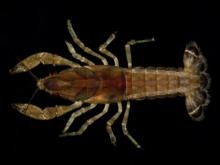
Species Types
Scientific Name
Faxonella clypeata
Description
The shield crayfish is small and tan, with a pattern of paired blackish dashes along the surface of the carapace and abdomen. The pincers are narrow, with short, abruptly tapering fingers. In Missouri it occurs only in our southeast counties.
Media
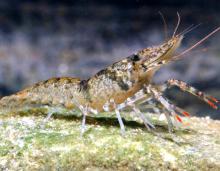
Species Types
Scientific Name
Faxonius lancifer (formerly Orconectes lancifer)
Description
The shrimp crayfish is medium-small, light reddish brown to gray, and thickly dusted with darker specks. Its noselike rostrum is unusually long, with the tip longer than the base, and the pincers are narrow and weak. It is found in the Bootheel.
Media
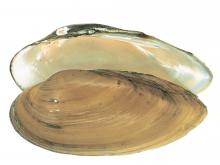
Species Types
Scientific Name
Lampsilis teres
Description
The uniform shell thickness and hard, white nacre made this mussel a favorite for button manufacturing, in the days before most buttons were made of plastic.
Media

Species Types
Scientific Name
Bivalve molluscs in order Unionoida
Description
Secretive and seldom seen, freshwater mussels are extraordinarily diverse in Missouri. We have nearly 70 species within our borders. Many are declining, and several are endangered.
Media

Species Types
Scientific Name
Macrobrachium ohione
Description
Of Missouri’s two species of freshwater shrimp, the Ohio River shrimp is certainly the rarest. It was thought to be extirpated from our state but was rediscovered recently in the Mississippi River.
Media
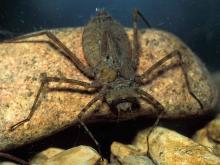
Species Types
Scientific Name
Species in the suborder Anisoptera
Description
Dragonfly larvae are aquatic insects with large eyes, six legs, and an oval or rounded segmented abdomen. The lower jaws are scooplike and cover much of the lower part of the head.
Media

Species Types
Scientific Name
Various species in the subclass Hirudinea
Description
Most people are repulsed by leeches. But once you get past the fact that many species are parasitic bloodsuckers, you will discover that they are fascinating creatures with an important role in nature.
See Also
About Aquatic Invertebrates in Missouri
Missouri's streams, lakes, and other aquatic habitats hold thousands of kinds of invertebrates — worms, freshwater mussels, snails, crayfish, insects, and other animals without backbones. These creatures are vital links in the aquatic food chain, and their presence and numbers tell us a lot about water quality.





















